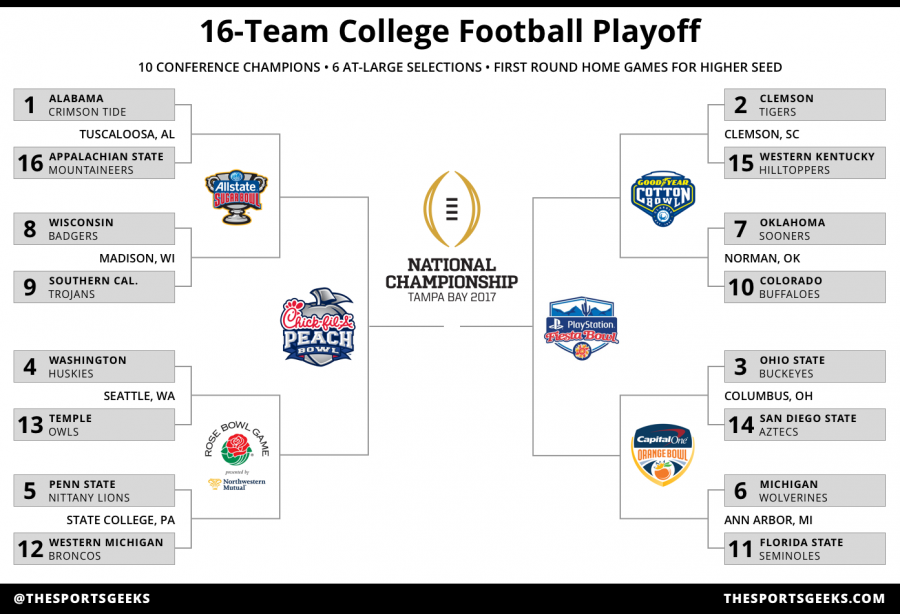Why the College Football Playoff committee should change to a 16-team format
Every year in college football there is one common goal for each team: to be a part of the four. What does it mean to be a part of the four? It means you are one of the four teams who get to play in the College Football Semifinals and compete for a National Championship.
 In the five short years since the playoffs have started, 11 different teams have made the playoffs. Alabama and Clemson lead the NCAA with 5 playoff appearances each, the next team to make it the most is Oklahoma with 4. There have been 6 teams to make it once, Oregon, Washington, Florida State, Michigan State, Georgia, and LSU. The rest of the playoff appearances have been awarded to Ohio State.
In the five short years since the playoffs have started, 11 different teams have made the playoffs. Alabama and Clemson lead the NCAA with 5 playoff appearances each, the next team to make it the most is Oklahoma with 4. There have been 6 teams to make it once, Oregon, Washington, Florida State, Michigan State, Georgia, and LSU. The rest of the playoff appearances have been awarded to Ohio State.
Every college football fan can agree with me that it is the most annoying thing hearing Alabama’s or Clemson’s name called every year. Most people believe that an 8 team playoff would bring a nice change to the postseason, but I believe a 16 team playoff would be much more interesting. A 16 team playoff would cause mass chaos, bring in more fans, and would make a championship team much more memorable.
Upsets are one of the biggest fears or hopes of all college fans. The fear for fans is that if your team is close to contention, they will not lose a game that will make them drop far in the rankings. An upset win, on the other hand, would definitely make your team shoot up higher in the rankings. If your team was not ranked, then the committee will look at that win with a lot of respect and potentially put them in the top 25.
If a 16 team playoff were to be established, a team’s dreams of making the playoffs would not disappear with a loss. For example, when the playoff rankings came out in 2015, Oklahoma State had jumped up to number 6 and was 10-0. With 2 weeks left before bowl seasons, all Oklahoma State had to do was beat Baylor and Oklahoma. The Baylor match-up was the first game and came into the game ranked number 10. The winner of this game would get major respect from the playoff committee and be looked at like a clear playoff candidate. Baylor would walk right into Stillwater, Oklahoma, and show the Cowboys how real they were. Baylor would upset Okie State and the Cowboys would fall to number 11 and would shake the team’s confidence. It doesn’t help that the next week Okie State would also lose to Oklahoma the next week, but the final rankings would see Okie State be ranked at 16 which would mean they would be the final team in the 16 team bracket. Okie State could have been one of the worst teams to be matched up with and would have made a game versus number 1 Clemson very upset worthy.
2016 saw a rise of one of the fallen kings of college football. A former football dynasty like Miami was finally competing for a national championship, something they haven’t done since they got robbed of a title against the refs’ favorites, Ohio State. Number 2 Miami was one week away from playing in the ACC Championship versus number 1 Clemson. It would not even have mattered if either team lost an undefeated championship game because they both would have made the playoffs most likely. The chance of both of these teams making the playoffs was taken away by an unranked Pittsburgh. Miami traveled up north to an ice-cold Pittsburgh, Pennsylvania to blow the game and lose 24-14. Miami would fall to number 7 before losing again to Clemson. Just like with Oklahoma State, Miami could have made a deep playoff run and upset some higher-seeded teams.
 In 2017, the “National Champions of College Football” was apparently the University of Central Florida. The UCF football team crowned themselves the national champions after finishing the year undefeated and upsetting number 7 Auburn in the Peach Bowl. UCF was kept down at number 12 until they finally beat Auburn. The committee looked down on UCF the whole season because of their strength of schedule and also for not having a key big win over a high ranked opponent. A 16 team playoff would have seen UCF win at least one game in upset fashion, and I believe UCF would have shocked the world.
In 2017, the “National Champions of College Football” was apparently the University of Central Florida. The UCF football team crowned themselves the national champions after finishing the year undefeated and upsetting number 7 Auburn in the Peach Bowl. UCF was kept down at number 12 until they finally beat Auburn. The committee looked down on UCF the whole season because of their strength of schedule and also for not having a key big win over a high ranked opponent. A 16 team playoff would have seen UCF win at least one game in upset fashion, and I believe UCF would have shocked the world.
Now that we have talked about the chaotic side of things, we can finally talk about how 16 teams would bring in more fans.
This has to do with the formatting of the playoffs. The match-ups would be 1 vs 16, 2 vs 15, 3 vs 14, 4 vs 13, 5 vs 12, 6 vs 11, 7 vs 10, and 8 vs 9. If each top-ranked team won it would be 1 vs 8, 2 vs 7, 3 vs 6, then 4 vs 5. If one of the top-ranked teams were to lose, then the winner of that game would replace the team they beat. An example would be if the 12th seed knocked off the 5th seed, the 4th seed would play the 12th. After this, we would look at the semi-finals. The semi-finals in this situation would be the same as the normal playoffs with 1 vs 4 and 2 vs 3. Then we finally get a national championship game and can crown a champion.
Frankly, every game besides the 1 vs 16 and 2 vs 15 match-ups are all really upset worthy. The number 3 and 4 spots are usually one-loss teams, so somewhere along the way, they had either lost a big game to a good team or had been upset. Fans are sick and tired of watching the same top tier teams play, and it would be nice to see lower-ranked teams upset a higher seed and make a title run just like in March Madness.
More fans would watch and be able to attend the games too, which brings in a lot more money. In my format, the first 8 games would either be played at the higher seeds home arena or a neutral site. A home game for the higher seed would unite a campus and bring major attention to the town. For example, with this year’s rankings as of right now, Alabama would host Iowa in the first round. The game would be played in Tuscaloosa, Alabama, and be played at Bryant-Denny Stadium. Bryant-Denny holds up to 101,821 people, so it would be very capable of filling up the whole stadium with a plethora of Alabama fans and Iowa fans. The city of Tuscaloosa would also bring in a ton of money as people from all over the country would travel to watch the game. Hotels, restaurants, and tourist attractions would all make large profits that they would usually never see.
In some cases, smaller cities like South Bend, Indiana—where Notre Dame plays—would get the chance to build after the revenue gained from hosting a game. On the other hand, if Northwestern was higher in the rankings, the city of Chicago would be a perfect environment for a playoff game. Yes, it would be cold and snowy because the game would be played in either late December or early January, but a historical city like Chicago provides so much for all the people who would travel to watch two top tier teams play.
After the first eight games are done, the next 6 would be New Year’s Six Bowls as these games would be the playoff quarter-finals and semi-finals. The Rose Bowl, the Orange Bowl, the Cotton Bowl, the Peach Bowl, the Fiesta Bowl, and the Sugar Bowl are some of the most anticipated games of the year. Instead of having a committee decide who gets to play in these games, let the pressure build-up and make the 16 teams fight to play. The national championship would then be played at a neutral site in which no team would have played in to get to the game. Likewise, a city like New Orleans which hosts the Sugar Bowl would not host the national championship. Instead, a city like New York or Detroit could host it so that a different city can make money each year.
 The last reason the playoff committee should make a change to a 16 team playoff would be because the team to win would be much more memorable. I am not saying a team like LSU who just won the championship last year won’t be remembered as one of the best teams of all time because it was, but a team who had to win 3 games against top 16 teams just to get to a national championship would be one of the best teams of all time. Not to mention, they would also be beating a 4th top 16 team to win a national championship.
The last reason the playoff committee should make a change to a 16 team playoff would be because the team to win would be much more memorable. I am not saying a team like LSU who just won the championship last year won’t be remembered as one of the best teams of all time because it was, but a team who had to win 3 games against top 16 teams just to get to a national championship would be one of the best teams of all time. Not to mention, they would also be beating a 4th top 16 team to win a national championship.
So let’s run through a bracket where all the top seeds won, but the 16th seed upsets everyone on their way to win a national championship. Iowa in the first match-up beats Alabama and would then move on to their first New Year’s Six Bowl against Cincinnati. After beating Cincinnati, Iowa would move on to a game with Ohio State where they would also win. The final game would be Iowa versus Notre Dame and Iowa would come out as National Champions. It would be crazy to look back and think wow, the team on the bottom defied the odds and beat everyone in front of them, but this new system would create a fury of excitement throughout college football.
Check out Joe’s story on why the CFP should expand to 8 teams, and Adam’s on why it should stay as is!
Should the College Football Playoff be expanded to eight teams?
Why the current College Football Playoff system needs to stay

Mac Boike is a junior at FHC entering his first year in the Sports Report. Mac enjoys playing lacrosse and football. He also enjoys playing box lacrosse...


























































































